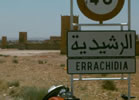
The Tafilalt - Gateway to the Sahara
After almost three weeks in the Atlas mountains, I reached the edge of the Sahara with my bike. With the scalding breath of the Sahara in my face, I followed the lush, green banks of Ziz river, as it winds its way through the Tafilalt to Rissani. One of Morocco's empirial cities, Rissani is now a dusty desert town (the other empirial cities are Fes and Meknes). The Ziz continues due south, toward the Algerian border, eventually evaporating in the blazing Sahara heat.
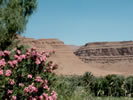
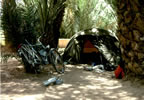 After
that, I was pretty glad to see the signs for the "source bleue"
and I veered off the road, down a dirt path to the famous place. All of
a sudden I was surrounded by the palm trees and fields that line the banks
of the Ziz river. I checked into the camp ground, piched my tent and went
for a swim.
After
that, I was pretty glad to see the signs for the "source bleue"
and I veered off the road, down a dirt path to the famous place. All of
a sudden I was surrounded by the palm trees and fields that line the banks
of the Ziz river. I checked into the camp ground, piched my tent and went
for a swim.
La source bleue de Meski is a popular, if touristy, camping place for Sahara travellers. When I camped there, the place was packed with Unimogs, Land Rovers, Toyota Land Cruisers and BMW Paris-Dakar motor bikes. I was the only guy with a bicyle and a tent.
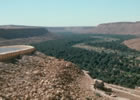
The river Ziz (left) has cut about 300 feet (100m) deep into the dusty, flats of the Tafilalt. Its banks at the bottom of the canyon are lush and green. Farmers carefully divert the water from the river onto their fields, using an intricate systems of canals that carry the precious wet practically to every individual plant.
The second day of Sahara biking started out mor pleasant, as the road descends form the hamada into the river valley. I got some georgeous views of the Tafilalt as I slowly rolled down the road that snakes along the steep rocky cliffs. Down in the valley, the road winds through the small villages along the river, crossing the Ziz and finally I headed into the town of Erfoud.
On the last stretch from Erfoud to Rissani, all of a sudden the sky turned a funky yellow color, the wind kicked up some dust eddies. I realized that one of those suffocating dust storms was headed my way. I wrapped my head in a shirt and pushed on. Soon a curtain of dust slammed into me like a sandblaster. I had to lean into the wind, my head low over the handlebar and my eyes on the two visible meters of street in front of me. It took me the better part of the afternoon for the 20 KM to Rissani, and I arrived exhausted, covered in dust,
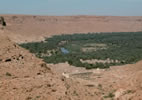
I stayed a couple of weeks with a friend in Rissani. The Saharouis are yet another breed apart from the Fassi or the Berber in the mountains. Although more reserved than most Moroccans, except for the Berbers in the mountains, their hospitality, once extended, is extensive and very warm. They are mostly a very devout, conservative people, yet this was one of the rare occasions where I had an opportunity to get a glimpse of the women's world. My friend's mother, a wonderful, lively woman, proudly explained me that she had not set foot outside the family compound for more than 20 years. However, inside the house she ruled with firm, unwavering hand.
My frinds and I took trips to the Ziz, and to several kasbahs in the area. Most of these fortified mud-and-wood constructions are still inhabited and closed to foreigners. After a lengthy discussion with a guard at a particularly imposing and old complex, I was admitted for a brief tour. The inside of this kasbah made the medina of Fes seem spacious. It was just all one single, multi-story complex, like a 500-year-old apartment building. Inside it was relatively cool and quite dark. Enourmous, ancient wooden beams held up the ceilings, some well over foot in diameter, and bent down so much that one had to duck under them.
After two weeks in Rissani, I took an overnight bus back to Rabat, to
get a visa for Algeria. My plan was to ride my bike into Algeria, across
the Sahara, as far as I could make it in the middle of summer. However,
I ended up changing my plans.